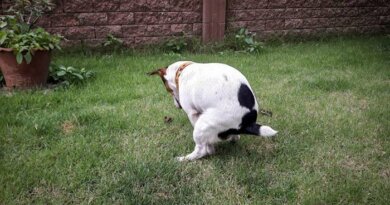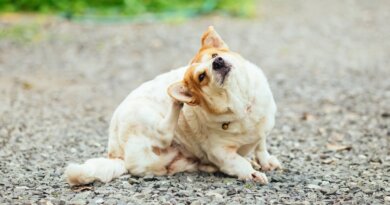How You Handle Pet Food Could Be Making Your Dog—And You—Sick
April 12, 2022 – Patrick McIntyre loves his two labs, ages 5 and 6. So much so that he and his wife make their own dog food to provide them with the best nutrition possible for long and healthy lives. Part of that approach involves handling food safely, just as the couple would handle their own food.
“We clean up after making and serving them food, don’t leave food out after they’ve eaten it, and wash their dishes after every meal,” says McIntyre. “I wouldn’t want to leave my bowls sitting out on the floor, so why would I leave my dogs’ bowls there?”
While the McIntyres’ approach might seem time-consuming and over the top, it turns out they’re onto something. According to a new analysis published in the journal PLOS One, in-home pet food handling and food dish hygiene practices can have bad health effects for both humans and pets.
Despite the concern for contamination, the study found that few guidelines exist for pet dish hygiene and safe food handling.
“In my clinical experience, I don’t think many people consider safe food handling with their pets,” says Stephanie Sheen, a doctor of veterinary medicine (DVM) at Fuzzy Pet Health, an online pet health service.
And while some tenets of safe food handling carry over from the human side of the equation, some do not, says Sheen.
“There are many food safety issues that apply to pets and not humans,” she says. “For starters, dogs eat directly from their bowls, and their mouths have high bacteria levels.”
It’s the contamination that can happen in pet food bowls that puts them at highest risk for bad effects from poor practices. This applies to both the bowls and the food that goes into them. When it comes to food safety and your pets, there’s a lot to learn.
Better Bowls
The reality is, pet owners are pretty lax about cleaning their pet’s bowls, and here’s why that matters: “Studies have shown that pet food bowls are on the top-10 list of most contaminated and dirty items in a household,” says Lindsay Butzer, DVM, from PetMeds, a pharmacy for pets. “One small chore that many pet owners neglect now that they’re heading back to the office or simply getting out of the house more is cleaning their pet’s food bowls.”
When bowls are left uncleaned, residue from food and your dog’s saliva is left behind, providing a breeding ground for potentially dangerous bacteria. “Common bacteria that can easily grow on day-old dog food includes salmonella and E. coli,” says Butzer, which can upset your dog’s stomach if eaten daily.
According to the PLOS One analysis, an earlier study performed cultures on household objects and found staph bacteria in 15% of pet food bowls. Antibiotic-resistant staph bacteria – or MRSA – was present in 3% of samples.
While the food bowls are most at risk for contamination, don’t neglect changing out and washing your pet’s water bowls as well, says Sheen. “Your dog’s saliva builds up over time in the bowls they use, which can create a film over bacteria, allowing it space to breed,” she says.
This is particularly true with plastic or ceramic bowls. “The concerns here are scratches or chips in the surfaces, which provide a harbor for bacteria,” says Sheen. “You can’t get into these spots for a good washing. If you do use these types of bowls, it’s best to replace them once they get damaged.”
Consider using stainless steel bowls, which are more resistant to damage and which you can easily throw in the dishwasher after a feeding. “You should also disinfect them once a week with two tablespoons of bleach in a gallon of water,” Sheen says.
Better Food Handling
According to Sheen, most people feed their pets one of three types of diets: raw, fresh-cooked, or commercial. Of the three, a raw-food diet is most likely to result in contamination.
“There can be really bad strains of bacteria in a raw diet, even antibiotic-resistant bacteria,” she says. “It’s very important to clean these bowls after each meal, as the residue is more likely to stick to the bowls and attract bacteria. Make sure you wash your hands well with soap and water after handling raw food, too.”
With dry food, your risk is lower, but it still requires safe handling practices. Wash the bowls out once a day, and avoid scooping up the dry food with the bowl your pet will eat from, as this can transfer any contamination from the bowl to the bag.
With wet, canned food, anything your dog doesn’t eat should be removed after 2 hours and thrown out, before it can become a bacteria breeding ground. Leftovers should go into the refrigerator, where they can safely stay for about 2 to 3 days.
Finally, with fresh-cooked foods, “think of them as you would your own meats, keeping them for about 3 days before discarding,” says Sheen.
The PLOS One survey found that most pet owners fail in this area, storing pet food against FDA and most manufacturers’ recommendations.
The Risks
The good news is that for most healthy, young dogs older than 6 months, the risks of poor food handling are generally low.
The most common signs of contaminated food bowls are diarrhea, loss of appetite, and vomiting, says Butzer. “Death is extremely rare unless the bacteria have built up over several weeks and your dog eats a very large amount.”
The concerns for safe food handling go beyond your pet’s health. Because of your close, daily interactions with them, your pet can easily share their bacteria with you.
While it’s not pleasant to think about, some dogs love eating feces on walks; they then return to your house and lick your face, potentially spreading contamination. The same holds true if they pick up bad bacteria from poor food handling and then again share their sloppy kisses with you.
“For people over 65, children under 5, or those who are immune-compromised, this can be risky,” says Sheen. “This especially holds true with dogs who eat raw-food diets – dog therapy groups don’t allow these dogs, for that reason.”
At the end of the day, a little effort goes a long way to protect both your pet and your family.
For the McIntyre family, where Patrick’s wife has a severe gluten allergy, food safety is second nature, and it pays off for everyone involved. “We’re responsible for our dogs’ health as well as ours,” he says. “We’ve got a set of food safety rules for everyone involved.”




